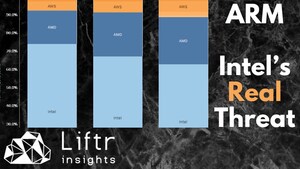AUSTIN, Texas, Oct. 22, 2020 /PRNewswire/ -- Liftr Insights, a pioneer in hybrid alternative data, identified new AWS Wavelength zones and Local Zones that Amazon Web Services ("AWS") made available to developers. Specifically, AWS Wavelength zones appeared before AWS updated its website to reflect new zone activations.
"We were aware that AWS was promoting Wavelength zones, but finding more regions in the data than AWS had originally announced demonstrates the value of our alternative data for investors who want information ahead of the news," says Tab Schadt, CEO of Liftr Insights. "It seems an unfair advantage for our customers, but it's fully compliant."
What are AWS Wavelength and Local Zones?
Both Local Zones and Wavelength zones directly connect end-users to zone compute and storage resources, providing single-digit millisecond latency between end-users and the AWS zone.
AWS Local Zones are smaller deployments of physical compute, storage and networking infrastructure located near end users who do not have a full-blown AWS region located nearby. The goal of Local Zones is to reduce latency and improve the user experience for customers to use applications such as video rendering and graphics-intensive virtual desktop applications.
AWS Wavelength zones are intended to connect applications running in full AWS regions to telecom carrier 5G networks with the lowest possible latency. Target applications for AWS Wavelength are internet of things (IoT) devices, game streaming, autonomous vehicles, and live media production.
Why do financial investors care about new AWS low latency zones?
Financial investors prefer data over speculation, particularly when they have access to the data before other investors. Each of these new low-latency zones requires dedicated data center infrastructure. All the new zones planned by AWS depend on new processor and compute accelerator purchases.
"For example, AWS's initial IaaS deployments into AWS Wavelength and Local Zones are all based on Intel Xeon Scalable generation 1 and 2 processors ("Skylake" and "Cascade Lake")," explains Paul Teich, Semiconductor and Cloud Subject Matter Expert. "In addition, the only compute accelerator chip deployed in these new zones is NVIDIA's Tesla T4 GPU."
Investors realize this information provides valuable insights not only on AWS's worldwide growth, but also on the supply chain brands and products AWS chooses to support that growth.
About Liftr Insights
Liftr Insights hires subject matter experts (SMEs) to translate company-specific service provider data into actionable alternative data. For example, their semiconductor and public cloud SME translates vendor-specific data from the top public cloud service providers, such as Amazon Web Services, Microsoft Azure, Alibaba Cloud, and Google Cloud, as well as semiconductor vendors AMD, Intel, NVIDIA, and Xilinx. Hedge funds and investment banks can easily ingest this timely, standardized and SEC compliant information into their predictive financial models.
Liftr Insights provides a high-level map overlay of service growth and availability for the four tracked cloud service providers at https://bit.ly/LiftrCloudRegionsMap.
Liftr and the Liftr logo are registered service marks of Liftr Insights. The following are trademarks and/or service marks of Liftr Insights: Liftr Insights, Liftr Cloud Components Tracker, and Liftr Cloud Regions Map.
The following are registered intellectual property marks, trademarks or service marks of their respective companies, along with related icons and logos:
Amazon
Amazon Web Services
Microsoft Azure
Alibaba Cloud
Google Cloud
Intel Corporation
NVIDIA
AMD
Xilinx
SOURCE Liftr Insights

Related Links
WANT YOUR COMPANY'S NEWS FEATURED ON PRNEWSWIRE.COM?
Newsrooms &
Influencers
Digital Media
Outlets
Journalists
Opted In





Share this article